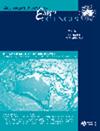Formation of Cu–Au porphyry deposits: hydraulic quartz veins, magmatic processes and constraints from chlorine
IF 0.9
4区 地球科学
Q3 GEOSCIENCES, MULTIDISCIPLINARY
引用次数: 2
Abstract
Abstract Copper–gold porphyry deposits are the world’s main source of copper and a significant source of gold. They consist of vein networks and their surrounding alteration zones. Commonly the deposits are centred on narrow intrusions (stocks), but calling these deposits ‘porphyries’ is unjustified because the name carries little descriptive or genetic value. Extensional veins were formed by hydraulic fracturing of the stocks, at depths where open spaces could not be maintained and where fluid pressure approaches lithostatic pressure. The post-crystallisation timing of the veins is important because it indicates that the host stocks could not have been the direct sources of either metals or ore-forming fluids. In the traditional magmatic model, precursor batholiths, lying at depth, are inferred to be the sources of the Cu and Au in the overlying host stocks. In this model, the batholiths are assumed to have crystallised and produced the mineralising aqueous fluids, Cu and Au. However, in many porphyry deposits, the concept of metal and fluid supply from deeper batholiths is problematic. Neither Cu nor Au is strongly enriched during the crystallisation of silicate magmas, and although hypersaline fluids are a characteristic of Cu–Au porphyry deposits globally, the source of the Cl remains unconstrained. There is little evidence that silicate magmas can release such Cl-rich fluids, and it remains unexplained how elevated levels of Cl may be achieved in a silicate magma. Therefore, the starting assumption that these deposits formed predominantly from magmatic sources and processes is questioned. This study has selectively focused on the roles of rheology, rock mechanics, vein control, metal-enrichment processes and the sources of Cl. Non-magmatic processes may be enough to facilitate strong partitioning of Cu and Au into high-temperature, oxidising, high-salinity, hydrothermal fluids to form Cu–Au porphyry deposits. KEY POINTS Mineralised quartz veins were introduced in fluids during hydraulic fracturing of their host intrusions when these stocks were brittle and had cooled significantly below their solidus temperatures. The porphyry intrusions hosting Cu–Au (copper–gold) mineralisation were not the direct sources of either the fluids or the metals. The sources of Cu and Au included large volumes of surrounding and underlying rocks up to kilometres from the sites of deposition. Cu and Au do not become strongly concentrated during crystal fractionation in evolving silicate magmas. Unaltered igneous rocks have relatively low Cl contents, and experiments suggest low Cl solubilities in granitic to granodioritic magmas. It is highly unlikely that all the Cl required for metal complexing and transport was available from within silicate magmas.铜金斑岩矿床的形成:水力石英脉、岩浆过程和氯的约束
摘要铜-金斑岩矿床是世界上铜的主要来源,也是金的重要来源。它们由脉网及其周围的蚀变带组成。通常,矿床以狭窄的侵入体(存量)为中心,但将这些矿床称为“斑岩”是不合理的,因为这个名字几乎没有描述性或遗传价值。伸展矿脉是通过储层的水力压裂形成的,在无法维持开放空间的深度,在流体压力接近岩石静压力的深度。矿脉结晶后的时间很重要,因为这表明宿主矿床不可能是金属或成矿流体的直接来源。在传统的岩浆模型中,位于深处的前体岩基被推断为上覆宿主岩中Cu和Au的来源。在该模型中,假设岩基已经结晶并产生矿化水性流体Cu和Au。然而,在许多斑岩矿床中,来自更深岩基的金属和流体供应的概念是有问题的。在硅酸盐岩浆结晶过程中,Cu和Au都没有强烈富集,尽管高盐度流体是全球Cu–Au斑岩矿床的特征,但Cl的来源仍然不受限制。几乎没有证据表明硅酸盐岩浆可以释放出这种富含Cl的流体,而且还无法解释硅酸盐岩浆中Cl水平是如何升高的。因此,这些矿床主要由岩浆源和过程形成的最初假设受到质疑。本研究选择性地关注流变学、岩石力学、矿脉控制、金属富集过程和Cl来源的作用。非岩浆过程可能足以促进Cu和Au强烈分配为高温、氧化、高盐度的热液流体,形成Cu–Au斑岩矿床。要点矿化石英脉是在其宿主侵入体的水力压裂过程中引入流体的,当时这些岩石很脆,并且已经显著冷却到低于其固相线温度。承载铜-金(铜-金)矿化的斑岩侵入体不是流体或金属的直接来源。Cu和Au的来源包括距离沉积地点数公里的大量周围和下伏岩石。在演化的硅酸盐岩浆中,Cu和Au在晶体分馏过程中不会变得强烈集中。未风化的火成岩具有相对较低的Cl含量,实验表明,在花岗质到花岗闪长质岩浆中,Cl溶解度较低。金属络合和迁移所需的所有Cl极不可能从硅酸盐岩浆中获得。
本文章由计算机程序翻译,如有差异,请以英文原文为准。
求助全文
约1分钟内获得全文
求助全文
来源期刊

Australian Journal of Earth Sciences
地学-地球科学综合
CiteScore
2.80
自引率
8.30%
发文量
45
审稿时长
6-12 weeks
期刊介绍:
Australian Journal of Earth Sciences publishes peer-reviewed research papers as well as significant review articles of general interest to geoscientists. The Journal covers the whole field of earth science including basin studies, regional geophysical studies and metallogeny. There is usually a thematic issue each year featuring a selection of papers on a particular area of earth science. Shorter papers are encouraged and are given priority in publication. Critical discussion of recently published papers is also encouraged.
 求助内容:
求助内容: 应助结果提醒方式:
应助结果提醒方式:


